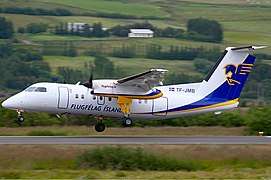Air Iceland Connect
Air Iceland Connect, formerly Flugfélag Íslands, is a regional airline with its head office at Reykjavík Airport in Reykjavík, Iceland.[1] It operates scheduled services to domestic destinations across Iceland and to Greenland and the Faroe Islands (operated by Atlantic Airways). Its main bases are Reykjavík Airport and Akureyri Airport.[2] It is a subsidiary of Icelandair Group.[3]
 | |||||||
| |||||||
| Founded | 1937 (as Flugfélag Akureyrar) | ||||||
|---|---|---|---|---|---|---|---|
| Hubs | Reykjavík Airport | ||||||
| Frequent-flyer program | Icelandair Saga Club | ||||||
| Fleet size | 6 | ||||||
| Destinations | 15 | ||||||
| Parent company | Icelandair Group | ||||||
| Headquarters | Reykjavík Airport Reykjavík, Iceland | ||||||
| Key people | Árni Gunnarsson | ||||||
| Website | airicelandconnect.is | ||||||
History
Air Iceland Connect can trace its history to 1937. On 3 June that year Flugfélag Akureyrar was established; the airline changed its name to Flugfélag Íslands on 13 March 1940, the third airline to bear this name. The first Flugfélag Íslands was founded on 22 March 1919 and dissolved the following year. A second airline of the same name was founded on 1 May 1928 and operated until 1931.[4] In 1973, Flugfélag Íslands and Loftleiðir merged under the name Flugleiðir hf. Its domestic division was called Flugleiðir while its transatlantic division was called Icelandair.[4]
In 1997, Flugleiðir's domestic operation merged with Flugfélag Norðurlands under the name Flugfélag Íslands.[4] Flugfélag Norðurlands was formed in Akureyri by Tryggvi Helgason as Norðurflug, and was incorporated as Flugfélag Norðurlands on 1 May 1975.
In late 2011, Flugfélag Íslands acquired two Bombardier Dash 8-200 aircraft for delivery in early 2012. Upon delivery of these aircraft, the airline sold its only Dash 8-100 series aircraft. It previously operated ATR 42 aircraft, wet leased from Islandsflug, from 2000 to 2003.[5] A fleet of three Bombardier Dash 8-Q400 aircraft replaced the airline's five Fokker 50 aircraft in 2015-16. Services using the new aircraft included routes to Aberdeen which started in March 2016, and Belfast which began in June 2017, both flown out of Keflavík International Airport.
In May 2017, Flugfélag Íslands announced it had rebranded as Air Iceland Connect. The airline said in a statement that it had decided to modify its name owing to a number of factors such as increased exposure to international markets and tourists, increased co-operation with Icelandair and to simplify marketing, as the company’s dual name system had meant a significant increase in costs, caused some passengers inconvenience, and led to misunderstandings.[6] Dropping the Icelandic name resulted in complaints about the attack on the Icelandic language.[7]
In February 2018, Air Iceland Connect announced a strategy change by focusing on regional destinations. Therefore, flights to the United Kingdom had been cut by 14 May 2018 and the Bombardier Dash 8 Q400s will be phased out.[8]
Air Iceland fleet
 Air Iceland (Flugfélag Íslands) De Havilland Canada DHC-6-300 Twin Otter
Air Iceland (Flugfélag Íslands) De Havilland Canada DHC-6-300 Twin Otter Air Iceland (Flugfélag Íslands) Fokker 50
Air Iceland (Flugfélag Íslands) Fokker 50 Air Iceland (Flugfélag Íslands) Bombardier Dash 8-100
Air Iceland (Flugfélag Íslands) Bombardier Dash 8-100.jpg) Air Iceland (Flugfélag Íslands) Bombardier Dash 8-200
Air Iceland (Flugfélag Íslands) Bombardier Dash 8-200.jpg) Air Iceland Connect Bombardier Dash 8 Q-400
Air Iceland Connect Bombardier Dash 8 Q-400
Destinations
The airline flies to these following cities in Iceland.
| City | Airport | Notes |
|---|---|---|
| Akureyri | Akureyri Airport | |
| Egilsstaðir | Egilsstaðir Airport | |
| Ísafjörður | Ísafjörður Airport | |
| Reykjavík | Keflavík International Airport | |
| Reykjavik | Reykjavík Airport | Base |
There are also regular and seasonal flights to Greenland.
| City | Airport | Notes |
|---|---|---|
| Kulusuk | Kulusuk Airport | |
| Nuuk | Nuuk Airport | |
| Ilulissat | Ilulissat Airport | Seasonal |
| Narsarsuaq | Narsarsuaq Airport | Seasonal |
Air Iceland Connect additionally cooperates and code-shares on flights to the Faroe Islands operated by Atlantic Airways as well as on services to Grímsey, Thorshofn, Vopnafjörður and Nerlerit Inaat Airport operated by Norlandair.
Fleet
As of February 2020, the Air Iceland Connect fleet consisted of the following aircraft:[10]
| Aircraft | In service | Orders | Passengers | Notes |
|---|---|---|---|---|
| Bombardier Q200 | 3 | — | 37 | TF-FXH is for sale. |
| Bombardier Q400 | 2 | — | 74 | |
| Total | 5 | — | ||
Among the destinations, most in Greenland and some in Iceland have runways less than 1,100 metres (3,600 ft) in length. The Q200 is the only aircraft type possessed by Air Iceland Connect compatible with such runways. Its retired fleet includes Fokker 50s.[11][12]
Accidents and incidents
- On 29 May 1947, a Flugfélag Íslands Douglas DC-3 with registration TF-ISI crashed at Héðinsfjörður, Iceland, in bad weather, killing all 25 on board. As of 2018 this is the worst aircraft accident to occur in Iceland.[13]
- On 26 September 1970, Flugfélag Íslands Fokker F27 Friendship, with registration TF-FIL, crashed into the mountains of Mykines in Faroe Islands, in heavy fog, killing the Icelandic captain and 7 Faroese passengers.[14][15] 26 passenger and crew survived the crash. Three passengers, who escaped with minor injuries, hiked for an hour down the mountain to the village of Mykines, alerting authorities. The majority of the villagers went up the mountain to aid the injured.[16]
- On 18 June 1980, Flugleiðir's Fokker F27 Friendship, with 19 people on board,[17] made an emergency landing on Keflavík Airport[18] after its landing gear failed to come down on its approach to Vestmannaeyjar. The pilots managed to lower two of the plane's three landing gears and successfully land the plane in Keflavík with minimal damage to the plane.[19][20][21]
- On 20 March 1982, the left engine of Flugleiðir's Fokker F27 Friendship, with registration TL-FLM, blew up during takeoff from Ísafjörður Airport, at the altitude of 490 feet. The pilots managed to put out the fire but could not lower the left landing gear due to the damage it sustained in the explosion. Instead of trying to land on the narrow Ísafjörður airport with only two wheels down, the captain decided to fly about 230 km to the much larger Keflavík Airport to attempt an emergency landing there. Despite the front part of the engine almost breaking of in the explosion, the plane managed to land in Keflavík with minimal additional damage to the plane. All 25 people on board survived without injuries.[22][23][24][25]
- On 11 March 1986, the pilots of a Flugleiðir Fokker F27 Friendship, with registration TL-FLO, aborted takeoff from Reykjavík Airport after hearing unusual noise coming from the plane but were unable to stop it before it reached the end of the runway due to wet conditions. The plane went off the end of the runway, hit a concrete ditch which resulted in the front landing gear breaking off, went through a fence at the edge of the runway and came to a halt on the middle of the Suðurgata, a busy traffic street, barely missing a large oil truck that had just passed by.[26] All 45 people on board escaped without injuries.[27][28][29]
- On 8 July 1986, a privately owned single engine Socata Rallye Tampico crashed during takeoff from Reykjavík Airport, slid into Flugleiðir's Fokker F27 Friendship, with registration TF-FLM, and caught fire. The Fokker was deboarding at the time and a stewardess managed to push three passengers out of the way just before the Tampico hit. The flight engineer of the Fokker had grabbed a fire extinguisher when he saw the plane crash and managed to contain the fire before another employee of Flugleiðir came with a second extinguisher and helped him put the fire out before it could reach the fuel gushing out of the damaged airplane. All four people on board the small plane were pulled out with minor injuries.[30]
- On 4 March 2011, a de Havilland Canada Dash 8-100 registered TF-JMB was hit by a microburst while landing at Nuuk Airport in Greenland. It touched down hard and the right main landing gear collapsed. The aircraft veered off the runway, tearing the nose landing gear off. The 31 people on board were unharmed, however, the aircraft was written off.[31][32]
- On 27 June 2020 Bombardier Dash 8-400 registered TF-FXI was flying Air Iceland Connect flight NY328 from Reykjavik to Egillstaðir. At 23000 feet in the air the pilots noticed a crack in the windshield and diverted back to Reykjavik no passengers were harmed in the incident.
References
- Home. Air Iceland Connect. Retrieved on 13 February 2011. "Air Iceland - Reykjavik airport - 101 Reykjavik"
- "Directory: World Airlines". Flight International. 2007-03-27. p. 58.
- "Air Iceland Connect". airicelandconnect.is. Retrieved 3 March 2018.
- "Flugsagan". flugsafn.is (in Icelandic). Icelandic Air Museum. Retrieved 3 March 2018.
- "Air Iceland fleet list". planespotters.net. Retrieved July 19, 2014.
- "Air Iceland rebrands as Air Iceland Connect". ch-aviation.com. Retrieved May 26, 2017.
- "New English name for domestic flight company in Iceland faces criticism". Iceland Monitor. 26 May 2017.
- ch-aviation.com - Air Iceland Connect to cut fleet, quit UK 16 February 2018
- "ROUTE MAP". airiceland.is. Retrieved 19 May 2018.
- "Global Airline Guide 2019 (Part One)". Airliner World. October 2019: 15.
- Milla Ósk Magnúsdóttir (21 April 2017). "Sögu Fokker vélanna hjá FÍ lýkur". RÚV (in Icelandic). Retrieved 3 March 2018.
- Birgir Þór Harðarson (21 April 2017). "Flugfélagið selur allar Fokker-vélarnar". Kjarninn (in Icelandic). Retrieved 3 March 2018.
- Accident description for Flugfélag Íslands Douglas C-47A-25-DK (DC-3) TF-ISI, 29 May 1947 at the Aviation Safety Network. Retrieved on 4 March 2018.
- "Átta létust í flugslysinu í Færeyjum". Tíminn (in Icelandic). 29 September 1970. pp. 1, 3. Retrieved 2 January 2019.
- "Flugstjórinn og sjö farþegar létu lífið". Þjóðviljinn (in Icelandic). 29 September 1970. pp. 1, 9. Retrieved 2 January 2019.
- "Sex Íslendingar meðal 34 um borð". Morgunblaðið (in Icelandic). 27 September 1970. p. 1. Retrieved 2 January 2019.
- "Mikil gleði þegar hættan var liðin hjá". Morgunblaðið (in Icelandic). 19 June 1980. Retrieved 2 January 2019.
- "Magalending í Keflavík". Tíminn (in Icelandic). 19 June 1980. Retrieved 2 January 2019.
- "Meistaraleg nauðlending". Þjóðviljinn (in Icelandic). 19 June 1980. p. 1. Retrieved 2 January 2019.
- "Hugsunin var öll hjá börnunum mínum". Vísir (in Icelandic). 19 June 1980. Retrieved 2 January 2019.
- "Snilldarleg nauðlending Fokkersins". Dagblaðið (in Icelandic). 19 June 1980. Retrieved 2 January 2019.
- "Hreyfillinn sprakk í aðeins 150 metra hæð". Dagblaðið Vísir (in Icelandic). 22 March 1982. pp. 1, 2, 4, 5, 48. Retrieved 2 January 2019.
- "Giftusamleg björgun". Þjóðviljinn (in Icelandic). 23 March 1982. pp. 1, 16. Retrieved 2 January 2019.
- Gísli Einarsson; Edda Sif Pálsdóttir (5 April 2018). "Man eftir bragðinu af samlokunni". RÚV (in Icelandic). Retrieved 2 January 2019.
- "Ég bjóst við meiri látum í nauðlendingunni". Morgunblaðið (in Icelandic). 23 March 1982. pp. 20, 21, 48. Retrieved 2 January 2019.
- "Olíubíll rétt slapp undan flugvélinni". Dagblaðið Vísir (in Icelandic). 11 March 1986. Retrieved 2 January 2019.
- "Flugstjórinn heyrði hávaða og ákvað að hætta við flugtak". Morgunblaðið (in Icelandic). 11 March 1986. pp. 1, 2, 30, 31, 52. Retrieved 2 January 2019.
- "Rann út á Suðurgötu". Þjóðviljinn (in Icelandic). 11 March 1986. pp. 1, 7. Retrieved 2 January 2019.
- "Rann stjórnlaust fram af brautinni". Tíminn (in Icelandic). 11 March 1986. pp. 1, 3. Retrieved 2 January 2019.
- "Flugvirki er talinn hafa forðað stórslysi er hann slökkti eld með snarræði". Morgunblaðið (in Icelandic). 9 July 1986. pp. 29, 48. Retrieved 2 January 2019.
- "Íslensk vél brotlenti á flugvellinum í Nuuk - allir farþegar ómeiddir" [Icelandic aircraft crashed at the airport in Nuuk - all passengers unharmed] (in Icelandic). 365. 4 March 2011.
- Accident description for Flugfélag Íslands de Havilland Canada DHC-8-106 TF-JMB, 4 March 2011 at the Aviation Safety Network. Retrieved on 4 March 2018.